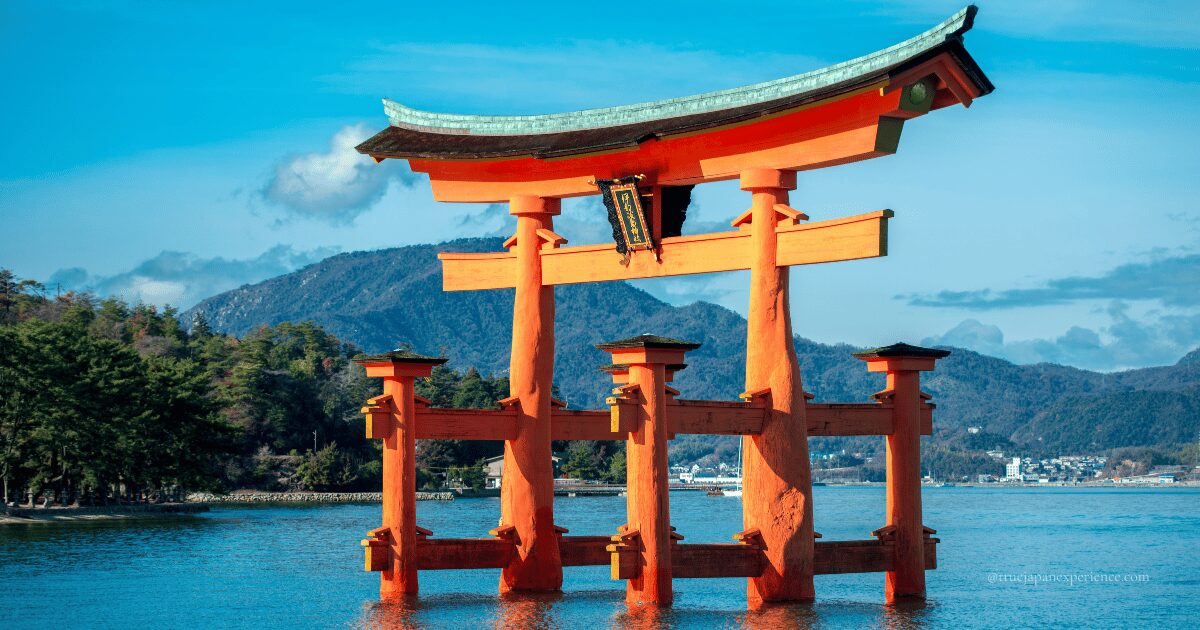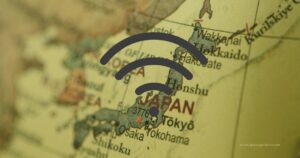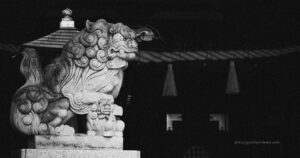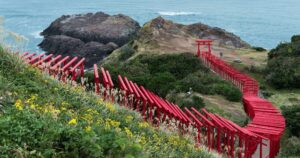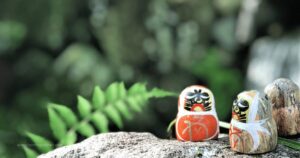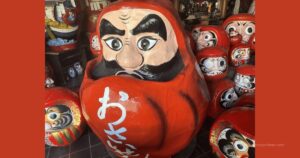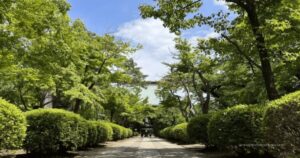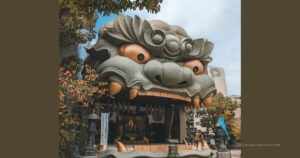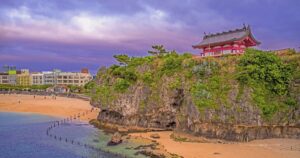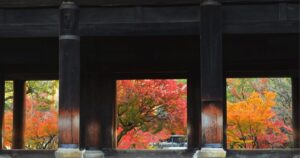Itsukushima Shrine Miyajima is one of the most famous places in Japan.
The shrine has a big red torii gate that stands in the sea—it’s called the Floating Torii Gate. People from all over the world come to Miyajima Island to see this beautiful view and explore the peaceful shrine.
In this guide, you’ll find out what makes it so famous, how to enjoy your visit, and how to get there easily.
Why Itsukushima Shrine Is So Loved
Itsukushima Shrine is one of the most famous shrines in Japan.
But why do so many people from around the world love it?
It’s not just about the red gate in the sea.
The long history, special location, and deep meaning all make it truly unique.
The Story Behind Itsukushima Shrine Miyajima
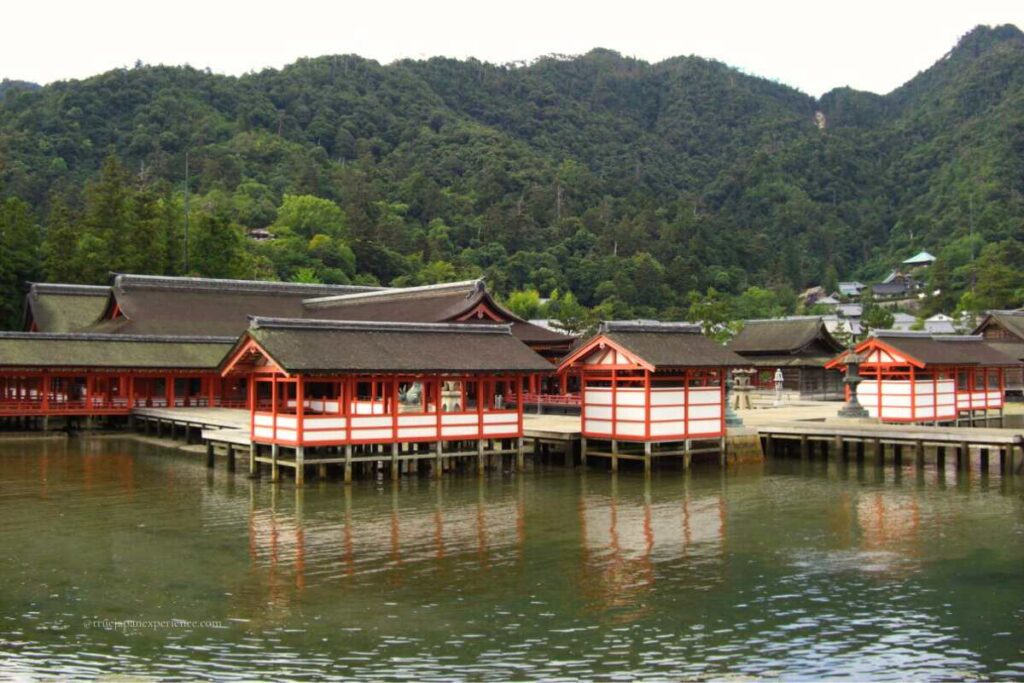
Itsukushima Shrine was first built more than 1,400 years ago. Later, in the 1100s, a powerful man named Taira no Kiyomori made it bigger and more beautiful.
Now, it’s a UNESCO World Heritage Site.
The buildings are made of wood and sit above the sea. They are connected by long red walkways. There’s even a special Noh stage and small shrines nearby.
The floorboards are not fixed with nails, and small gaps are left between them. This design helps stop the shrine from floating or moving during high tides. It helps protect the shrine when the tide gets high.
This clever idea shows how the builders worked with nature.
Floating Torii Gate of Itsukushima Shrine
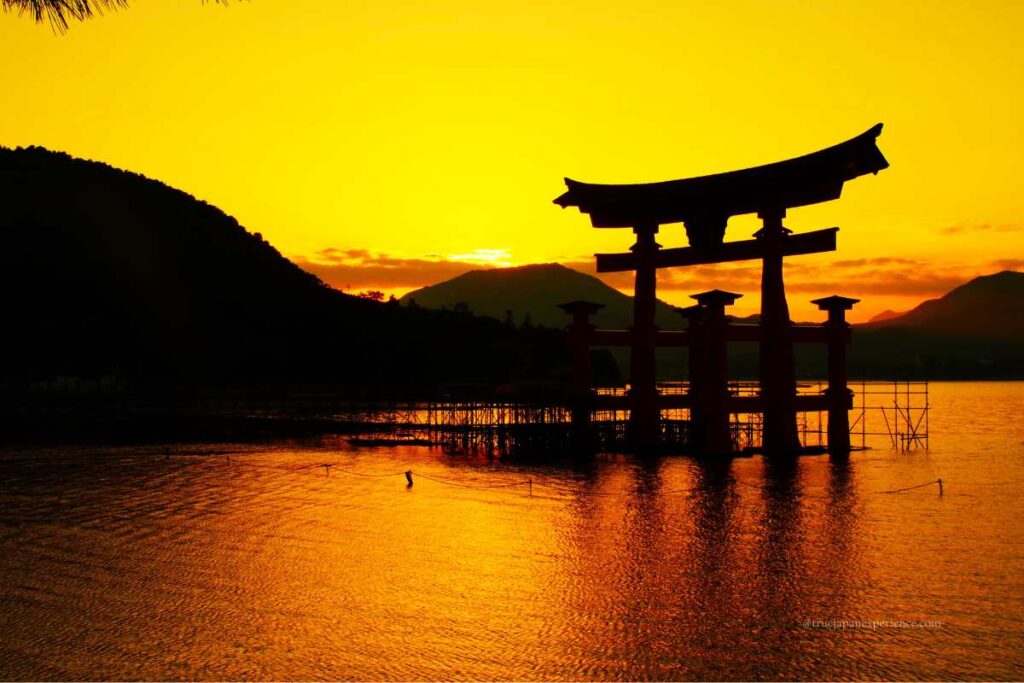
The large red gate standing in the sea is called the Great Torii. It’s the symbol of Itsukushima Shrine and one of the most famous views in Japan.
It stands in the sea, without any nails or cement. Just its own weight keeps it there.
The space under the roof of the Great Torii is hollow. Long ago, it was filled with 276 small stones. Each stone had one character from the Heart Sutra, a famous Buddhist text.
This means the torii—part of a Shinto shrine—was supported by stones from a Buddhist prayer. It shows how Shinto and Buddhism were deeply connected in Japan’s past.
Want to learn more about this mix of religions in Japan?
Read our guide: Shrines vs. Temples in Japan: What’s the Difference?
How the Tides Change Itsukushima Shrine on Miyajima
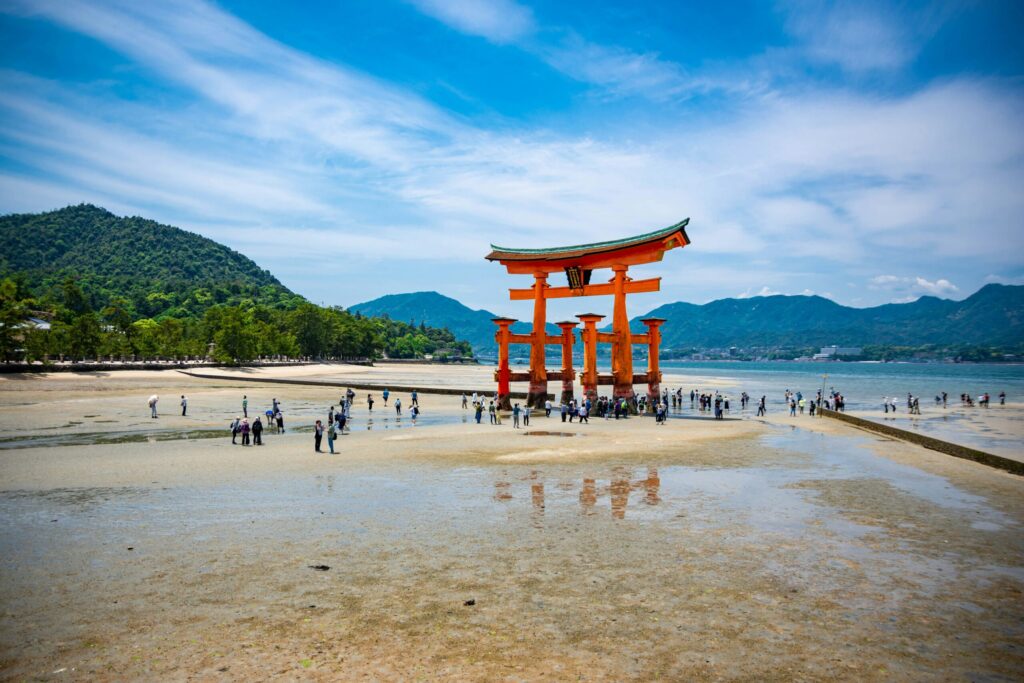
When the tide is high, the gate and shrine look like they are floating. It’s very beautiful and feels like a dream.
When the tide is low, you can walk across the sand and go close to the gate.
If the tide is just right, you might even take a small boat and get near the gate from the sea.
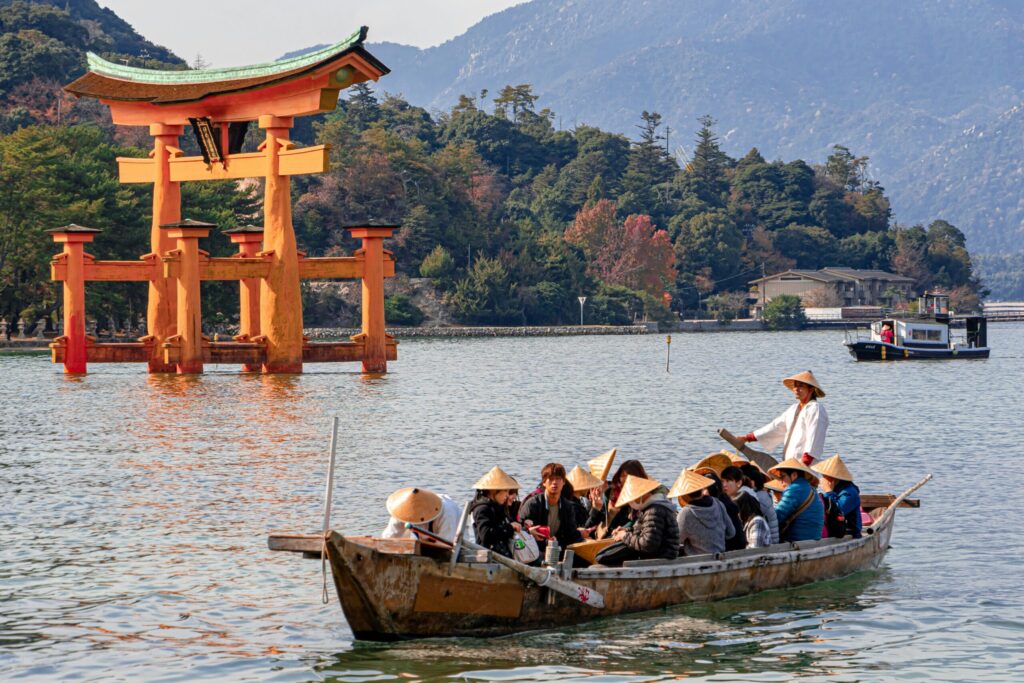
Before you go, check the tide chart:
・Under 100 cm – you can walk to the gate
・Over 250 cm – the shrine looks like it floats
Want to enjoy both? Stay one night on the island. You’ll have time to see both views and enjoy the quiet evening.
Miyajima’s Famous Deer and Island Life
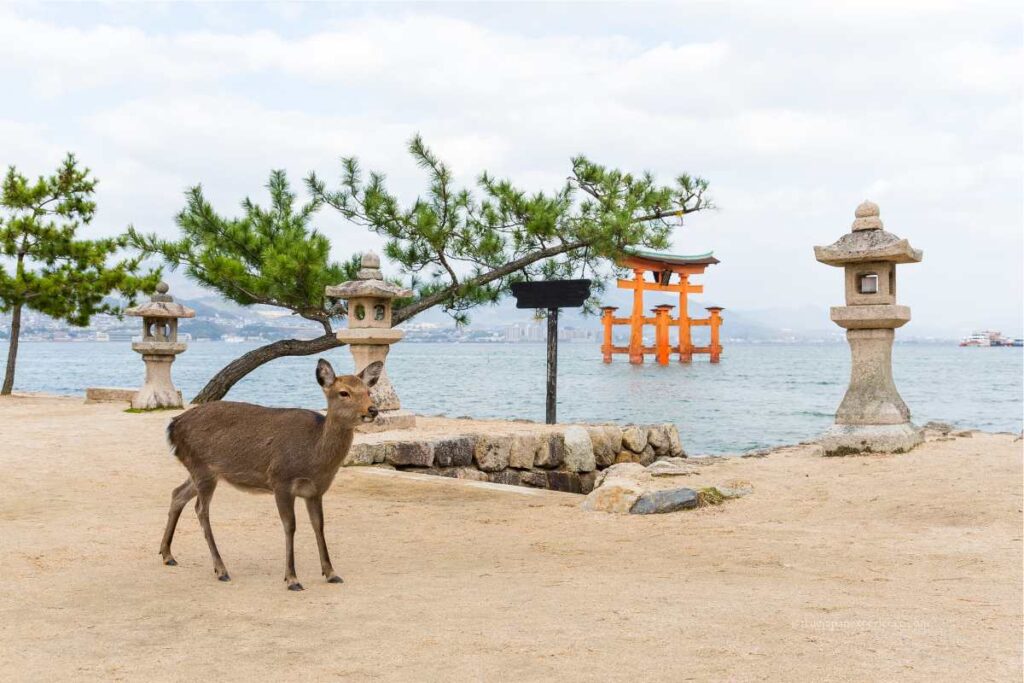
Miyajima is full of trees, fresh air, and peaceful spots.
Deer walk freely on the island. They are cute, but don’t feed them—some might get too friendly!
There’s a fun surprise too: many restrooms have special “deer doors.” These doors stop the deer from going inside and eating toilet paper!
Walking around the island is easy and fun. You’ll see forests, beaches, and small temples as you go.
Best Times to Visit Miyajima
Itsukushima Shrine on Miyajima changes with the tide. In one day, you can see it standing in the sea or sitting on the sand.
But the shrine and island also look very different with each season. Spring, summer, autumn, and winter all bring their own beauty.
Let’s take a look at what makes each season special.
Spring (late March–early April)
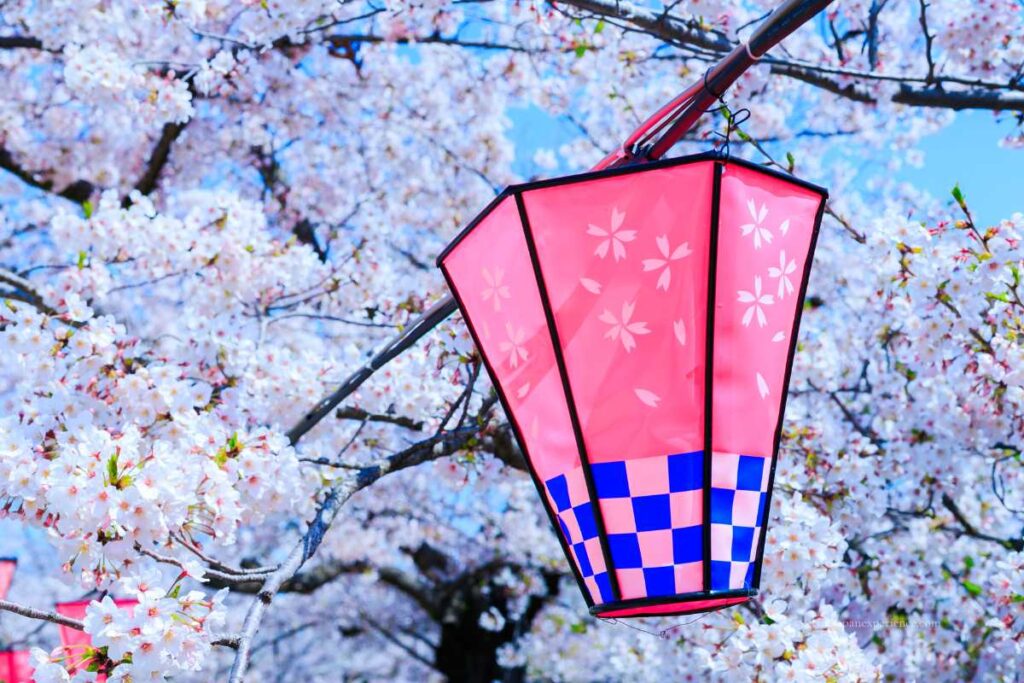
Cherry blossoms bloom across Miyajima in spring. The area near Daiganji Temple and the Five-Story Pagoda becomes pink and soft with flowers.
The weather is warm and perfect for walking around. It’s a peaceful time to enjoy the beauty of nature and the quiet sea.
Early Summer(June to early July)
Early summer is a quiet time before the big summer holidays.
The island is full of green trees and fresh air, but the days are starting to get hot and humid.
It can be easier to walk around and enjoy the views without too many crowds.
Autumn (October–November)
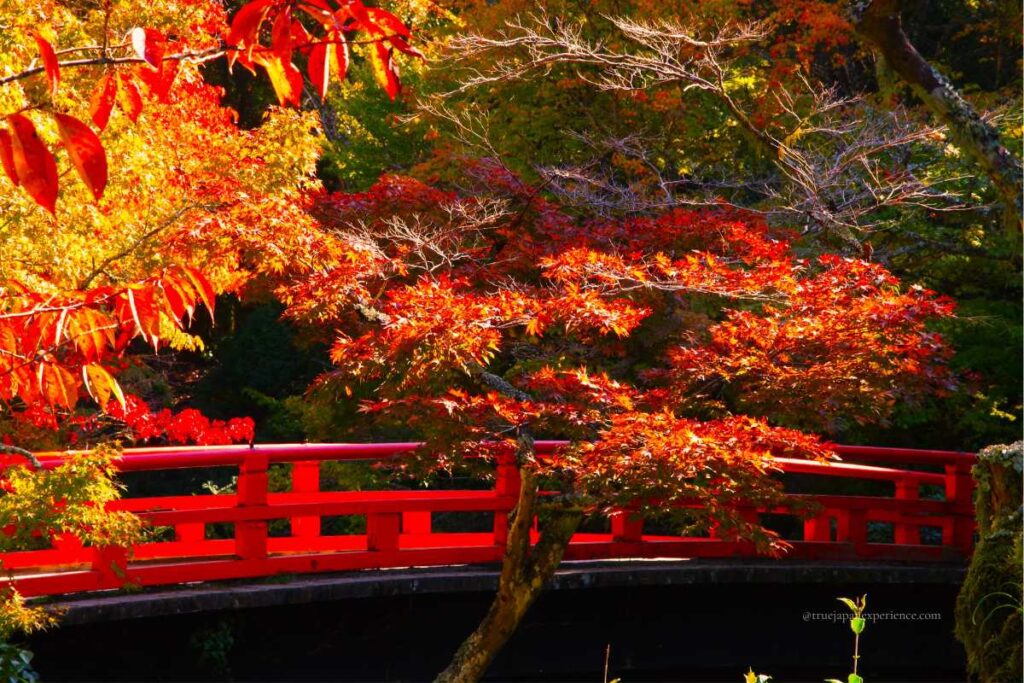
Autumn is the most colorful time on Miyajima. The maple trees turn red and orange, especially in Momijidani Park.
The bright leaves look beautiful next to the red shrine and the blue sea.
It’s a very popular time, so visiting on a weekday or early in the morning is best.
Winter (late February–early March)
Winter is quiet and calm. There are fewer people, so you can take your time and enjoy the peaceful island.
If you’re lucky, you might even see snow on the Great Torii or shrine roofs.
Also, it’s the best time to eat fresh oysters—one of Miyajima’s special foods.
Every evening, the shrine and gate are softly lit up. It’s quiet and peaceful, perfect for slow travel. Staying overnight makes this easy to enjoy.
How to Get to Miyajima
Many visitors to Japan start their trip in Tokyo, Osaka, or Kyoto. After seeing these popular cities, they often travel to Hiroshima and Miyajima.
Here is how you can get to Miyajima from each of these places.
From Tokyo
The fastest way from Tokyo to Miyajima is by bullet train.
Take the Nozomi Shinkansen from Tokyo Station to Hiroshima Station (about 4 hours).
If you are using a Japan Rail Pass, take the Hikari or Kodama instead. They take longer than the Nozomi, but you don’t need to pay extra.
It’s a good way to save money while traveling.
Want to learn more about using the Japan Rail Pass and riding trains in Japan?
Check out our guide here:
No IC Card? No Problem! Smart Ways to Ride Trains in Japan
You can also fly from Haneda or Narita Airport to Hiroshima.
The flight takes about 1.5 hours, and the airport bus to Hiroshima Station takes another 50 minutes.
You can also fly from Haneda or Narita Airport to Hiroshima. The flight takes about 1.5 hours, and the airport bus to Hiroshima Station takes another 50 minutes.
However, don’t forget to allow extra time for getting to the airport in Tokyo, going through security, and waiting for your flight.
After you land, you’ll also need time to transfer from Hiroshima Airport to the city. Overall, flying can take more time than it seems, so plan with care.
From Osaka or Kyoto
From Shin-Osaka Station, you can reach Hiroshima in about 1.5 hours by Shinkansen. If you’re coming from Kyoto Station, the ride takes a little more than 1.5 hours.
This route is smooth and comfortable.
Some travelers choose highway buses to save money, but they take around 7 to 9 hours.
From Hiroshima Station to Miyajima
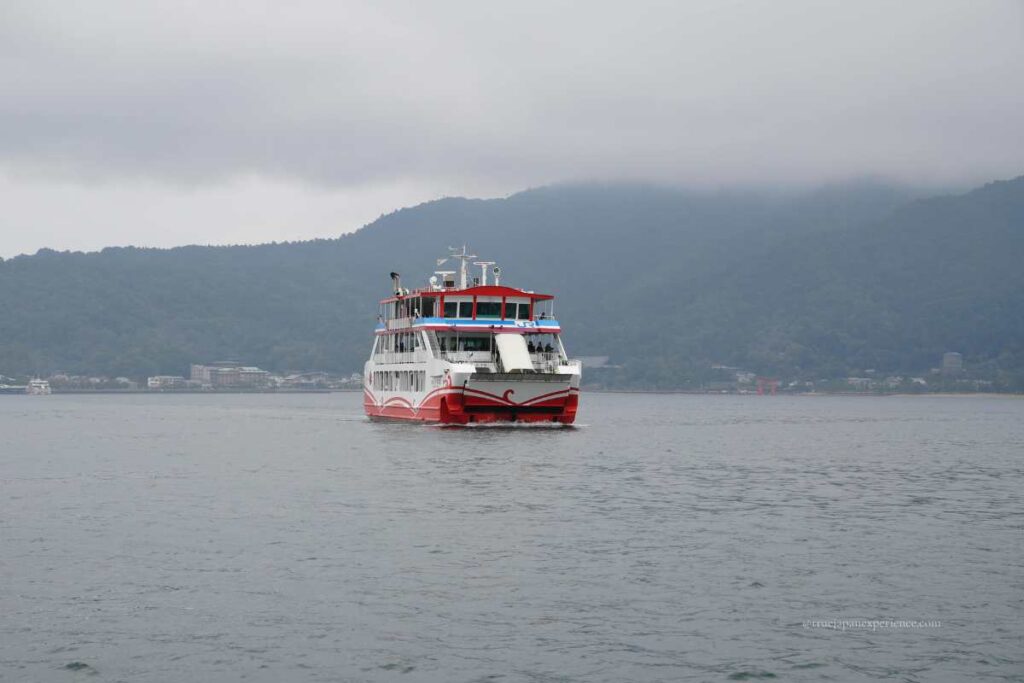
First, take the JR Sanyo Line to Miyajimaguchi Station. It takes about 30 minutes.
Then, walk a few minutes to the ferry terminal.
The ferry ride to Miyajima Island is about 10 minutes.
Once you arrive, it’s a 15-minute walk to Itsukushima Shrine along the main street.
What to Do on Miyajima Island
Miyajima has more to offer than just Itsukushima Shrine.
The island is full of nature, history, and local treats. Here are some of the best things you can enjoy during your visit.
One of the most popular things to do is ride the ropeway up Mount Misen. At the top, you can enjoy a great view of the Seto Inland Sea and nearby islands. If the weather is clear, you might even see as far as Shikoku.
Near the foot of Mount Misen is Daisho-in Temple.
This temple is full of small, unique statues, including hundreds of rakan (Buddhist disciples). It’s peaceful, colorful, and less crowded than the shrine.
If you visit in autumn, don’t miss Momijidani Park. This park is famous for its maple trees, which turn bright red and yellow. You can enjoy a quiet walk through the forest paths, especially early in the day.
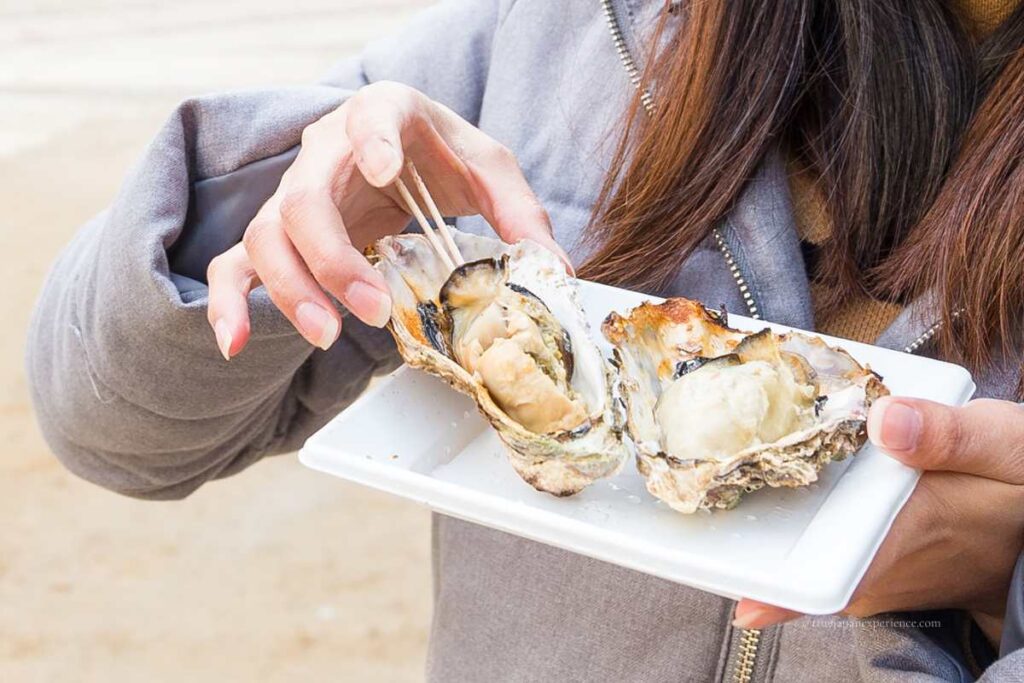
Miyajima is also known for delicious food.
Try freshly grilled oysters, one of the area’s most famous local foods. Another favorite is anago-meshi—grilled eel on rice.
And for something sweet, try momiji manju, small cakes shaped like maple leaves and filled with red bean paste or custard.
Before you leave, take a walk along Omotesando Street.
This is the island’s main shopping street, full of gift shops, street snacks, and fun souvenirs. It’s a great place to relax and find something special to remember your trip.
Miyajima Travel Tips and Visitor Info
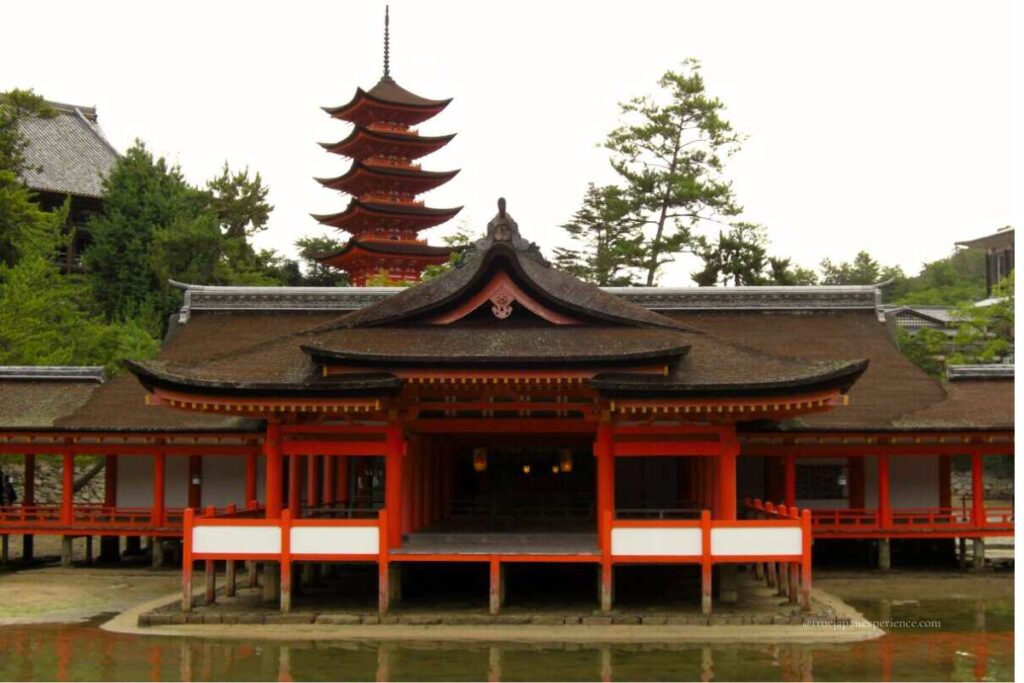
・Wear comfy shoes
・Check the tide before you go
・Don’t touch or feed the deer too much
・Go early or on weekdays to skip big crowds
You’ll also find English signs and maps around the island, so it’s easy to get around.
For more details about ferry times and tide schedules, check these official pages before your visit:
・Miyajima Tide Table (Japanese)
・Ferry Timetable and Prices (English)
Miyajima Island and Itsukushima Shrine are full of beauty and calm. The red gate in the sea, the peaceful paths, the friendly deer—everything feels a little special here.
Take your time. Enjoy the view.
This floating shrine isn’t just a place to see—it’s a place to remember.
